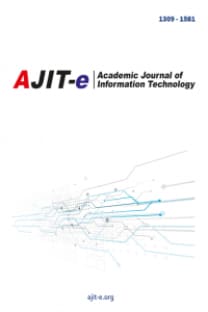Tedarik Zinciri Yönetiminde Gösterge Paneli Uygulaması
İşletmelerin küresel ortamda rekabet edebilmesi, bilgisayar sistemleri ve üretim yöntemlerindeki yeni gelişmeleri takip edebilmesine bağlıdır. Üretim yapan işletmelerin takip etmesi gereken yeniliklerden biride gösterge paneli(dashboard) uygulamalarıdır. Elektronik ortamlarda veri birikmesi ile birlikte, gösterge paneli hızla işletmelerde yaygınlaşmaya başlamıştır. Bu bağlamda gösterge paneli, özellikle üretim yapan işletmeler için, hızlı ve doğru karar alma noktasında iyi bir karar destek aracı olarak görülmektedir. Bu çalışmanın amacı, üretim sistemine entegrasyonu sağlanmış bir gösterge paneli uygulama örneğinin, ortaya koyulmasıdır. Gösterge panelinin, tedarik zinciri yönetim sistemine en uygun yaklaşım modelinin oluşturulmasıdır. Çalışmada, ayrıca bir tedarik zinciri yönetim sistemi modelinde, gösterge panelinin iş akışı paylaşılmıştır. Böylelikle, tedarik zinciri yönetim sistemi kullanan tüm işletmeler için, bir yol haritası olacağı düşünülmüştür. Çalışmada, üretim yazılımları kullanan her işletme için, karar alma bağlamında önemli bir karar destek aracı olacağı düşünülmüştür. Dolayısıyla, tedarik zinciri yönetimi yazılımı üzerinde, gösterge panelinin, karar alma ve iletişim çerçevesinde, örnek bir uygulamasını paylaşmış olacağız. Böylece, sonraki adımlarda, gösterge paneli başlığı altında, farklı tekniklerle biriken verilerin analizi yapılabilecektir.
Dashboard Application in Supply Chain Management
The ability of businesses to compete in a global environment depends on their ability to follow new developments in computer systems and manufacturing methods. It is a dashboard application from the innovations that the production enterprises should follow. With the accumulation of data in the electronic environment, the dashboard quickly became commonplace in enterprises. In this context, the dashboard is seen as a good decision support tool for fast and accurate decision making, especially for manufacturing enterprises. The purpose of this work is to demonstrate an example of a dashboard application that has been integrated into the production system. It is the creation of the instrument model that best fits the supply chain management system. In the study, also in a supply chain management system model, the workflow of the dashboard is shared. Thus, it is thought to be a roadmap for all businesses using the supply chain management system. In the study, it was thought that for every business using production software, it would be an important decision support tool in decision making context. So, on the supply chain management software, we will share a sample application of the dashboard in decision-making and communication framework. Thus, in subsequent steps, analysis of data accumulated by different techniques under the dashboard title will be possible.
Keywords:
Dashboard, Supply Chain Management Information Visualization, Data Analysis, Production Management System,
___
Bracht, U. (2011). A monitoring approach for the operative CKD logistics. Werkstattstechnik, 101(3), 122–17.Chopra, S. ve Meindl, P. (2015). Supply Chain Management: Strategy, Planning, and Operation, Global Edition. Pearson Education Limited. https://books.google.com.tr/books?id=gPDQCQAAQBAJ adresinden erişildi.
Ersezer, F. (2012). ERP ve tedarik zinciri yönetimi uygulamalarının rekabet avantajı ve örgütsel performans üzerine etkileri. Gebze Teknik Üniversitesi.
Gröger, C., Hillmann, M., Hahn, F., Mitschang, B. ve Westkämper, E. (2013). The Operational Process Dashboard for Manufacturing. Procedia CIRP, 7, 205–210. doi:10.1016/j.procir.2013.05.035
James, T. (2012). Smart Factories. Engineering & Technology, 7(6), 64–67.
Kağnıcıoğlu, C. H. (2007). Tedarik zinciri yönetiminde tedarikçi seçimi. Anadolu Üniversitesi yayınları: Endüstriyel Sanatlar Yüksekokulu yayınları. Anadolu Üniversitesi. https://books.google.com.tr/books?id=-DtXMwAACAAJ adresinden erişildi.
Lempinen, H. (2012). Constructing a Design Framework for Performance Dashboards (ss. 109–130). doi:10.1007/978-3-642-32270-9_7
Narasimhan, J., Krische, K. J., Susan, D. L. ve Charles, M. C. (2002). Analyzing the Analyst: When do Recomendations Add Value? http://gbspaper.library.edu/archive adresinden erişildi.
Özkan, O., Bayın, G. ve Yeşilaydın, G. (2015). Lean Supply Chain Management In Health Sector. AJIT-e Online Academic Journal of Information Technology, 6(18), 71–94. doi:10.5824/1309-1581.2015.1.005.x
Yigitbasioglu, O. M. ve Velcu, O. (2012). A review of dashboards in performance management: Implications for design and research. International Journal of Accounting Information Systems, 13(1), 41–59. doi:10.1016/j.accinf.2011.08.002
Yüksel, H. (2002). Tedarik Zinciri Yönetiminde Bilgi Sisteminin Önemi. Dokuz Eylül Üniversitesi Sosyal Bilimler Enstitüsü Dergisi, 4(3).
- Yayın Aralığı: Yılda 4 Sayı
- Yayıncı: AKADEMİK BİLİŞİM ARAŞTIRMALARI DERNEĞİ
Sayıdaki Diğer Makaleler
Instagram Hikayelerinde Benliğin Sunumu: Influencer’lar Üzerine Bir Araştırma
İlknur PASLANMAZ, Haldun NARMANLIOĞLU
Yusuf DEVRAN, Ömer Faruk ÖZCAN
Tedarik Zinciri Yönetiminde Gösterge Paneli Uygulaması
Yüksel YURTAY, Murat AYANOĞLU, Ömer Fatih BÖLÜKBAŞ
Artırılmış Gerçeklik Teknolojisinin Pazarlamadaki Yeri
Pınar AYTEKİN, Volkan YAKIN, Berke Han ÇELİK
Sosyal Medya ve Toplumda Değişen Estetik İşlem Yaptırma Algısı
Gül Dilek TÜRK, Serkan BAYRAKCI
Çağatay DEMİREL, Emre Ş. ASLAN
Dijital Hastalıkların Tespitinde Etik Bir Model Önerisi
Alaattin ASLAN, Mert KÜÇÜKVARDAR
